Why have we been waiting for the invention of the bike for so long?

The bicycle , as we know it today, was invented only at the end of the 19th century. However, it was a simple mechanical invention. It seemed that it does not require ingenious ideas and certainly no scientific preparation.
So why hasn't it been invented before?
I asked this question on Twitter, read the discussion of this question on the Quora service. Among the many proposed hypotheses were the following:
- Technological factors. In the 19th century, metalworking made a major breakthrough. We improved the cleaning of iron, and then of inexpensive steel, and learned how to better process metal and make parts such as hollow tubes. Wheel manufacturing technology has improved: wheels with wire spokes have replaced the heavier options; tires required vulcanized rubber (1839); Inflatable tires were only invented in 1887. Chains, sprockets, bearings - all these are necessary parts that required advanced manufacturing technologies to improve their quality and reduce cost.
- Stages of the project development. Early bicycles were uncomfortable and dangerous. The first option did not even have pedals. Some models did not have steering; turning on them could only be done by tilting. The famous penny-farthing scheme with a huge front wheel did not allow you to balance your legs, was at risk of a somersault during an abrupt stop, and the rider sat so high that he was constantly at risk of injury. Decades of gradual improvements have gone into creating a successful bike model.
- The quality of the roads. Until the 19th century, the quality of roads by modern standards was terrible. Often these were primers, with ruts from many passing carriages, turning into mud during rain. The crushed stone road, which made the surface smooth, was invented only in 1820. At that time, city roads were paved with cobblestone, suitable for horses, but too uneven for bicycles. (The roughness of the roads, apparently, was intentional, and helped in the event of a sewer overflow - as a result, one of the answers to Quora claims that the construction of the city sewer opened the door to bicycles).
- Competition on the part of horses. At that time, horses were a common and common transport. They coped with any roads. They could carry heavy loads. Who needs a bike? In this case, it is claimed that the bicycle was invented in response to a lack of food due to the “year without summer” in 1816, which occurred due to the eruption of the Tambor volcano in the previous year, due to which the sky darkened, and the temperature in many places on Earth dropped . The agricultural crisis led to starvation of both people and horses, which caused many horses to be killed for food, and the cost of feeding the remaining ones increased. This could serve as a motivation for finding alternatives.
- General economic growth. Many commentators have indicated that a middle class is required to demand such an invention. If you have only a bunch of poor peasants and a few aristocrats (who already have horses, carriages and coachmen), there is no market for bicycles. And this is a plausible option, if you remember that bicycles were first used for hobbies and entertainment before becoming a practical means of transportation.
- Cultural factors. Perhaps at some point in time there was simply no interest in useful mechanical inventions? But when did the situation change, and why?
All hypotheses are good. But some of them begin to yield under the pressure of analysis.
Road quality is relevant to the question, but not the answer. You can ride a bike on the dirt road or sidewalk (although the latter option led to clashes with passers-by and at first made the bikes unpopular among the public). Historically, roads did not improve until bicycles became widespread - apparently, cyclists became part of the force that required improving roads.
I do not think that the matter is in horses. Judging by the material I read, it was easier to buy a bicycle than a horse, and definitely easier to maintain (at least it does not need to be fed). It turns out that the inventors became interested in the problem of vehicles driven by muscular strength and allowing them to get rid of horses long before the advent of the modern bicycle. Even Karl Dres , who invented the first two-wheeled muscular vehicle after the “year without summer”, had been working on this task for many years.
Technological factors seem more convincing to me. They may have been necessary to make bicycles practical enough and inexpensive to gain popularity. But for early experiments, this was not important. Frames can be made of wood. The wheels can be finished with metal. Gear can not do. Chains replaced by belts; in some early designs, the pedals were located on the circumference of the wheel, and in one design, the wheels rotated levers, like on a steam locomotive.
So what is the correct explanation?
To understand this, I delved into the history of the bicycle.
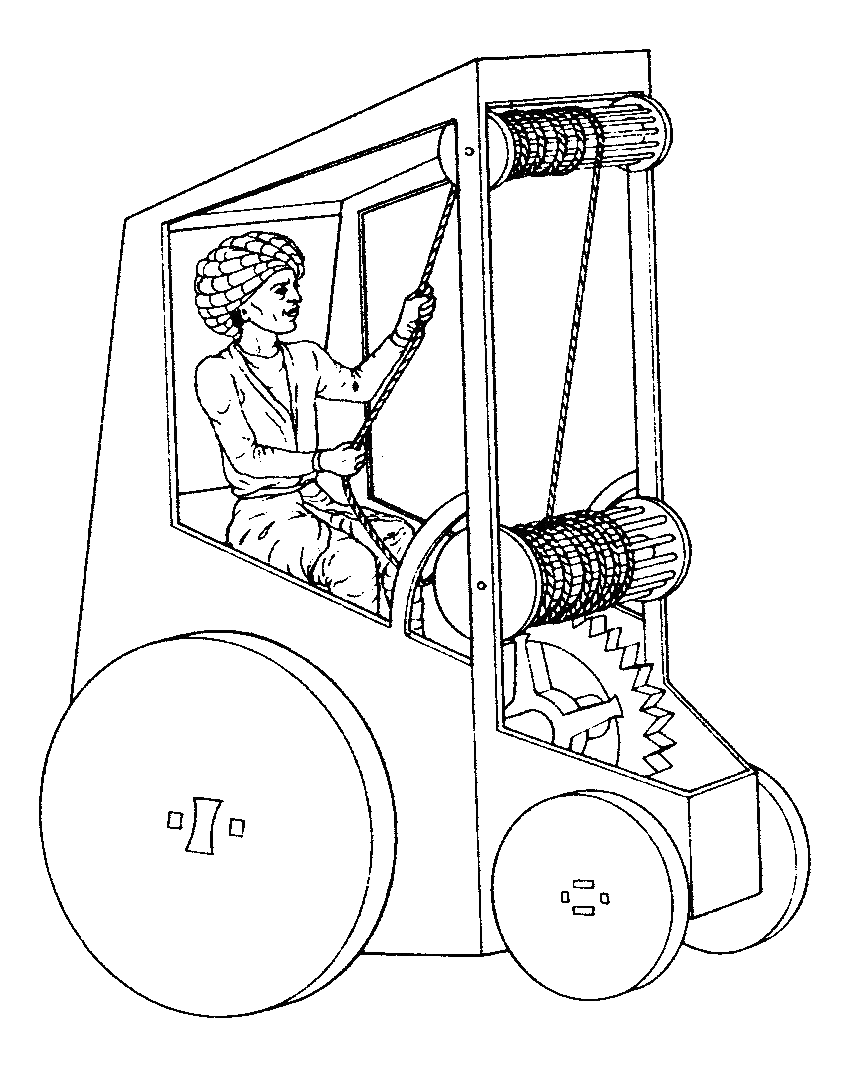
The concept of muscular traction vehicles goes back centuries. The first reference to him, of all that I found, was made by the Venetian engineer Giovanni Fontana , who described at the beginning of the 15th century a four-wheeled cart driven by a rider pulling on a rope that is looped to gears on wheels (it’s not clear if he tried to build such a car; Fontana generally made a bunch of sketches of strange things).
Another ancient concept is described in the book “Bicycle” by David Herlichai:
More than three centuries ago, the famous French mathematician Jacques Ozanam described the theoretical advantages of a muscular traction vehicle, in which "a person can ride as he wishes without horses." The owner of such a vehicle could freely move on the roads, without having to take care of the animal, and enjoy physical exercise in the process. Moreover, a “self-propelled” vehicle of this type, unlike machines requiring wind or steam, would work on the most accessible and plentiful resource of all: willpower. But how to build such a valuable car? This was the twenty-third of the fifty or so “useful and fascinating” problems identified and described by Ozanam in his famous work Récréations Mathématiques et Physiques, published in 1696.

Ozanam’s book proposed a solution from another inventor: another four-wheeled wagon driven by two people (one drives, the second set it in motion, stepping on large pedals connected by ropes, pulleys and gears).
Apparently, the cart has served as a model for muscular traction vehicles for centuries. Various inventors approached the design of such machines, and some were even built. The London magazine recorded a record race of such a cart in 1774, which reached a speed of 10 km / h. The French inventor Jean-Pierre Francois Blanchard (later famous as a pioneer of aviation and aeronautics), built a muscular traction car, which passed 15 km from Paris to Versailles. The American mechanic Bolton in 1804 built his own version, using the rotation of gears. Most likely, these inventions did not lead to anything, because the machines were too large and heavy to be of practical interest.
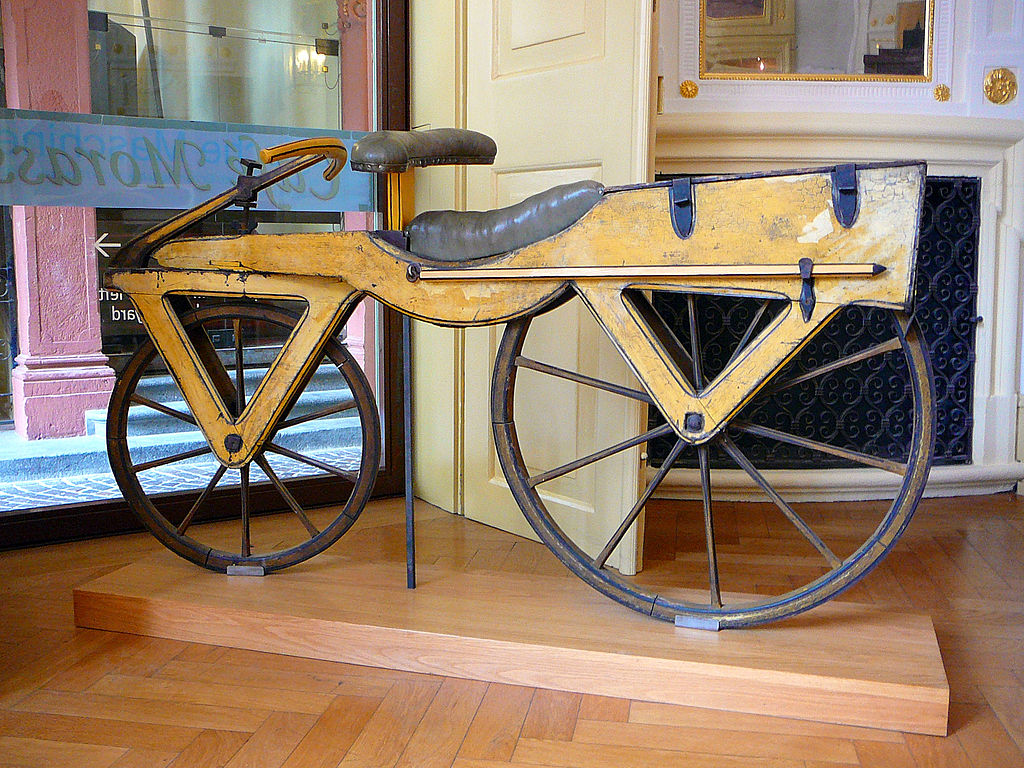
1820 Dresin (named after the inventor, Dresa)
The key idea was the idea that it was necessary to stop inventing a mechanical wagon and create something like a mechanical horse. Karl Drez took this path at the beginning of the 19th century. He was an aristocrat who held the position of "forest manager" in Baden, which gave him time to think and experiment. He directed his first attempts in 1813 to four-wheeled carriages, like his predecessors, and they just could not attract the interest of the authorities.
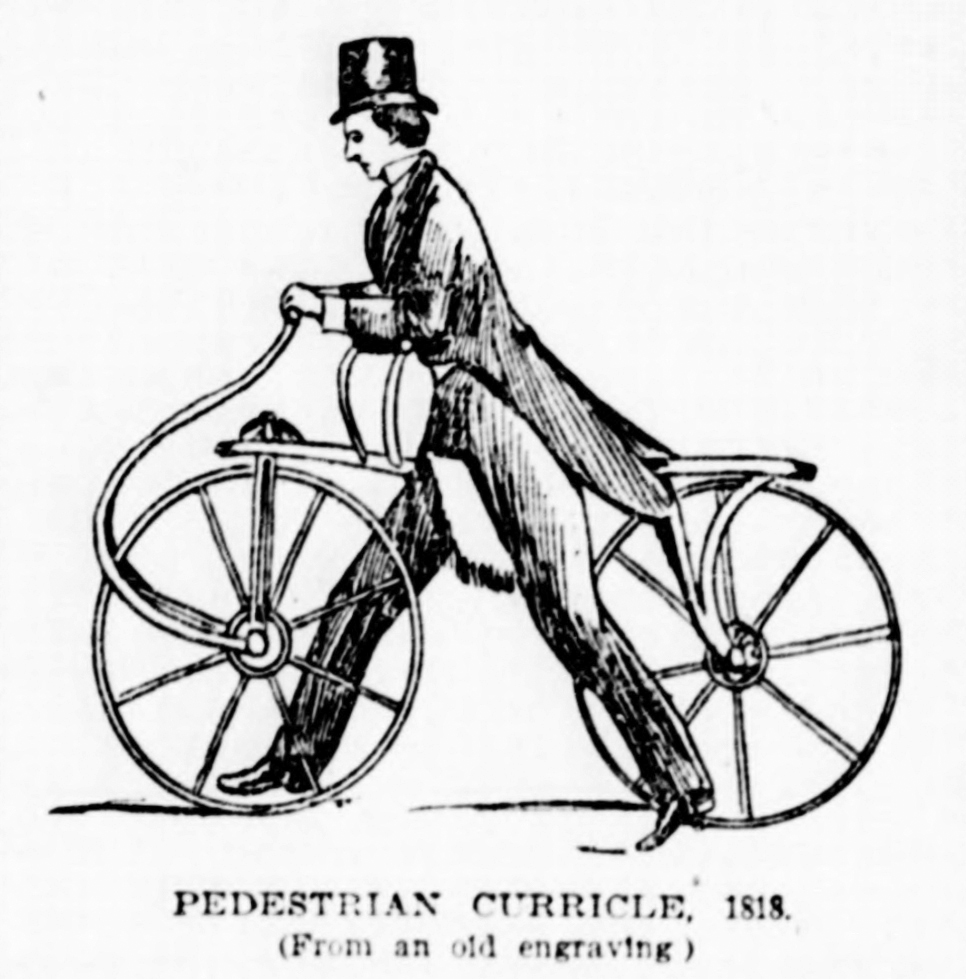
New York Tribune, September 1894
But in 1817 (perhaps under the influence of the food crisis and a shortage of horses, although this is not accurate), he again approached this idea, with a new project: two-wheeled transport designed for one person, in which you can easily recognize the ancestor of a modern bicycle. It was made of wood and had iron tires. The inventor called it Laufmaschine, the "running machine"; he had no pedals, and the rider needed to push off the ground with his feet. It was also called the "bicycle" from the Latin "fast foot", or "trolley" in honor of the inventor; The improved version created by the London-based manufacturer of wagons became known in England as the “pedestrian curricle”.
Without pedals and gears, this proto-bike could not achieve the speed and efficiency of modern ones. However, in the manner of scooters existing today, he allowed a person to ride on the road, especially downhill, and kept the rider's weight. Drez reached speeds of up to 19 km / h on it. The invention was a passing hobby in Europe 1818-19 years, and then went into decline. Apparently, the reasons for the recession were the potential insecurity and annoyance of people because they tried to ride on these sidewalks and in parks (some things never change; today, scooter wars flare up with renewed vigor).
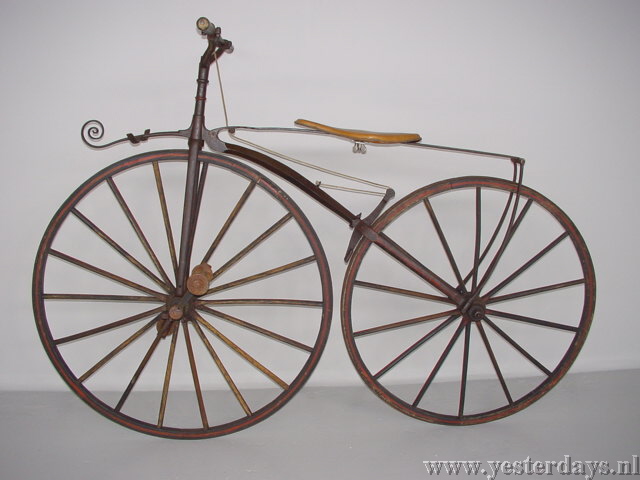
“The Shaker” by Pierre Michaud, 1870
The next key breakthrough came only a few decades later, when someone came up with the idea to attach pedals to a bicycle. At the expense of the first inventor, there is conflicting information (dating back to 1839), but in France in the 1860s, the pedals were already unambiguously. In any case, it was in the 1860s that the development of bicycles really began. The pedals allowed the rider to ride faster and more efficiently. Such a model was produced in France, first with a wooden frame, and then with a steel frame, and it was called the “bone shaker” (from which we can conclude about the quality of the trip on it).
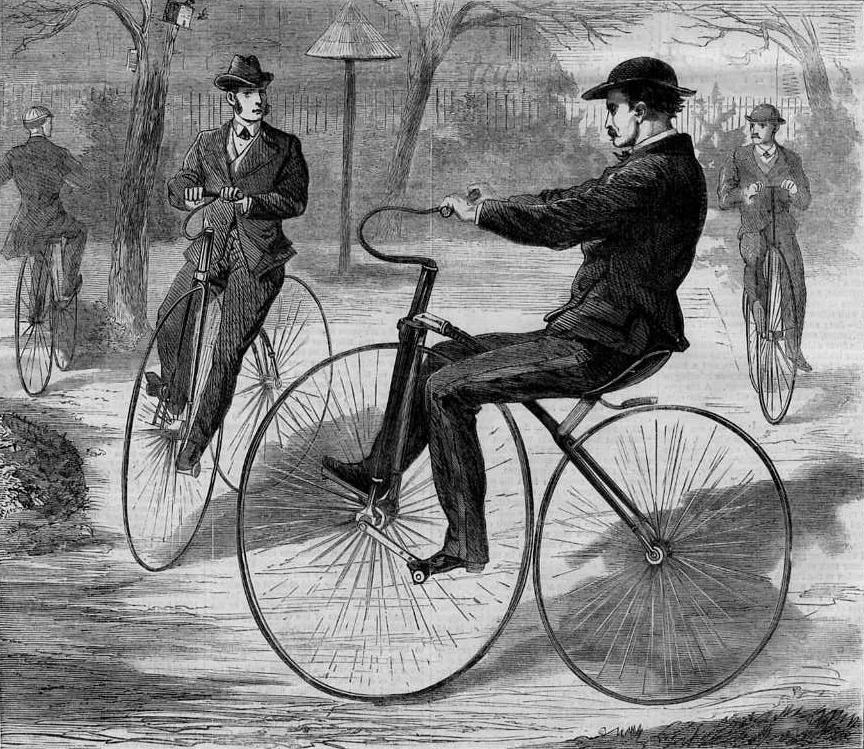
American Bicycle, engraving, 1868
However, at that moment the bicycle did not yet have gears or chains. The pedals were mounted directly on the front wheel. This did not give the rider serious mechanical advantages: it was the same as a fixed gear in a 1: 1 ratio (today, in most cases, 3: 1 gears are used). It's like riding a bike in the lowest gears - you pedal quickly, but you drive slowly.
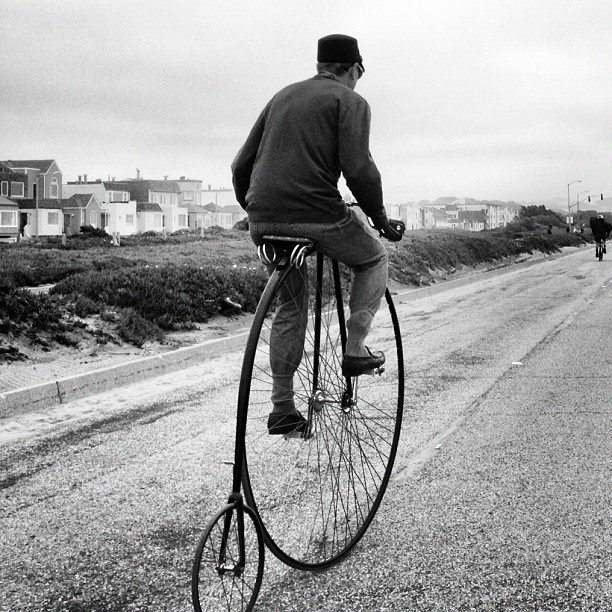
Penny Farthing Bike
The only solution was to increase the wheel, which led to the appearance of the ridiculous “penny-farthing” or “high wheel” bicycle in 1870, with a huge front wheel, which you probably saw, and you associate it with the end of the 19th century. By then, bicycles were made with a metal frame, wheels with wire spokes and rubber (not yet inflatable) tires. Such a scheme made it possible to drive faster and more smoothly, since the large wheel absorbed better when riding. However, it required acrobatic skill, was prone to falls and injuries, including somersaults through the front wheel during an abrupt stop.
The third and final key breakthrough, therefore, was the separation of pedals and wheels. Variants of such a "safe bike", among which there was at least one option with pedals on the wheel and levers, appeared in the 1870s, and maybe earlier. The first commercially successful model to use the familiar crankshaft and chain design was the 1885 John Starley model. Finally, in 1888, John Dunlop introduced inflatable (pneumatic) tires, which made the ride softer and eliminated the last advantage of the penny-farthing scheme.
So by the end of the 1880s, bicycles came to the shape that we know today, with wheels of approximately equal size, pedals, a chain, a metal frame, wheels with wire spokes, and inflatable rubber tires.
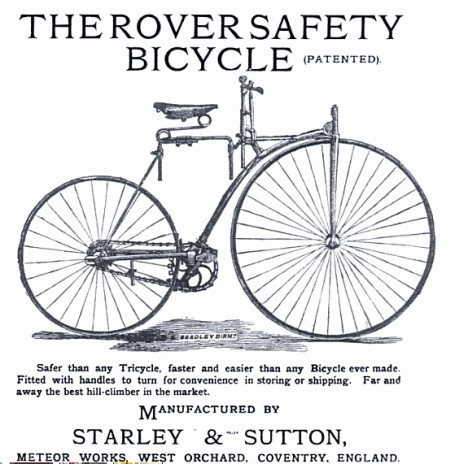
What conclusion can be drawn?
Firstly, the correct scheme was not obvious. For many centuries progress stalled due to the fact that the inventors tried to create four-wheeled carts for several people, instead of two-wheeled individual transport. It is not clear why this was so; naturally, the inventors copied the existing transport, but why did they draw inspiration only from a horse-drawn cart, and not from a rider and a horse? (Some commentators believe that the ability to balance on two-wheeled vehicles was not obvious, but this does not convince me, considering how many strange things people have learned to balance, from hollowed canoes to the horses themselves.) It is possible (but this is pure reflection) that early it was more difficult for inventors to understand the fundamental impracticality of mechanical carts, since they did not have mathematical engineering principles at hand, but then it was still not clear what led Drez to his breakthrough.
And even after Drez came across a two-wheeled scheme, it required several stages of improvement, which took several decades, in order to eventually come to an effective, convenient and safe form.
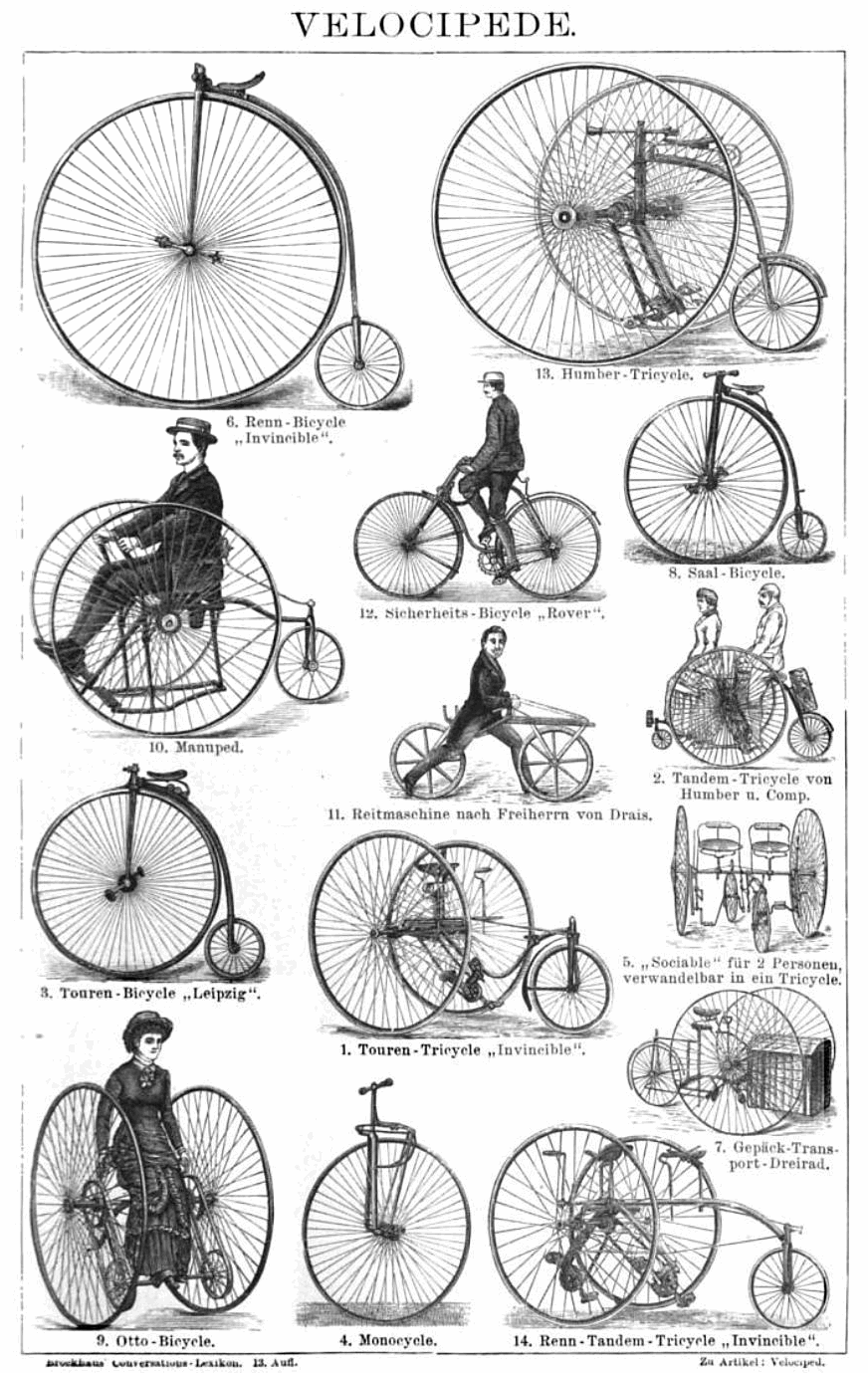
Early bicycle models from the 1887 German Encyclopedia
Secondly, it was likely that progress in materials and manufacturing was needed to create a commercially successful bike. Today it’s quite difficult to decide which breakthroughs in bicycle design became possible due to the emergence of new materials and technologies, and which were simply the results of glimpses of innovation that had not been thought of before. But the fact that people were ready to put up with an unreliable scheme with large wheels suggests that inflatable wheels were a critical innovation. It also seems reasonable to me that for making small and light chains and sprockets of high and constant quality at an affordable price, breakthroughs in metal processing were required - and that no other scheme, with levers or belts, would work. It also sounds logical that the wooden frames were not light enough and strong for practical use (today I would definitely not try to ride a wooden bicycle).
However, you can go further and ask questions that inspired me to study this topic. Why didn’t anyone even experiment with two-wheeled vehicles until the 19th century? Why no one, as far as we know, even theoretically considered the idea of muscular traction transport until the 15th century? Why weren't bicycle mechanics invented in the 14th century, when watchmakers already existed, or at least in the 16th century, when wristwatches appeared? Or did the ancient Romans build watermills and harvesting machines? Or the Greeks who created the antikythera mechanism? Even if they did not have chains and tires, why didn't these societies at least experiment with trolleys? Or even with unsuccessful schemes of four-wheeled carts?
To at least somehow begin to answer these questions, it is worth understanding that these facts are part of a broader phenomenon. I asked the same questions about Cotton Gin , the first efficient ginning machine, which, unlike a bicycle, did not need any special materials: a wooden box, wire mesh and a drum with wire teeth; it was so simple that after the concept was published, the planters made pirated copies of it on their own (depriving Eli Whitney of most of the patent fees). The same question can be asked regarding all key inventions in textile mechanization; Anton Howes, a historian of economics, joined the discussion on Twitter, mentioning the John Kay weaving “flying” shuttle :
Kay's innovation was outstanding in its simplicity. As the inventor Bennett Woodcroft wrote, people weaved with the help of an ordinary shuttle "for more than five thousand years, millions of experienced workers have been doing this, and no improvements have been made to speed up the work until 1733." Kay added a little wood and some ropes. And he applied all this to the manufacture of woolen fabrics, to the main industry of England from the Middle Ages. He did not have much experience, he did not need to understand the scientific side of the process, he did not have any special incentives for this. As for the idea itself, the flying shuttle was considered illegal because it saved labor, the patent was immediately copied by competitors, and Kay had to emigrate to France under the pressure of angry weavers that threatened his property and even his life. Kay didn’t just have no incentives, he invented in spite of frightening social and legal obstacles.
There are other stories where at first attempts were made to invent something new, but the idea did not get followers if it was not fully formed, after which its development stopped for decades. Richard Trevitik's unsuccessful experiments with locomotives come to mind.
In light of the above, I think that the main factors are the economic and cultural situation as a whole. Economic factors create the need for added value, supporting the general cultural research and development that generates inventions. Karl Dres was a baron on a sinecure, and was engaged in inventions in his spare time. In that era, it was common for inventors: often they were aristocrats or had other independent incomes (and the rest had to seek the support of wealthy sponsors). Today, universities and corporations have research laboratories, and venture investors are financing the development of new products and services. As soon as the possibility of a certain innovation becomes clear, several teams compete in attempts to bring it to the market. There are no decade-long failures in the schedule of inventions, or much less.
Economic factors of demand and added value also create markets for new products. Perhaps per capita GDP should reach a certain value before people have time, free attention and energy to think about new inventions that are not related to obtaining food, clothing and providing a roof over their heads.
There are cultural factors. Howes says that “innovation is not inherent in man, but is taken for granted. People do not invent often because it never occurs to them. ” Joel Mokier echoes him that "progress is not something natural." And I agree with them on this.
All Articles